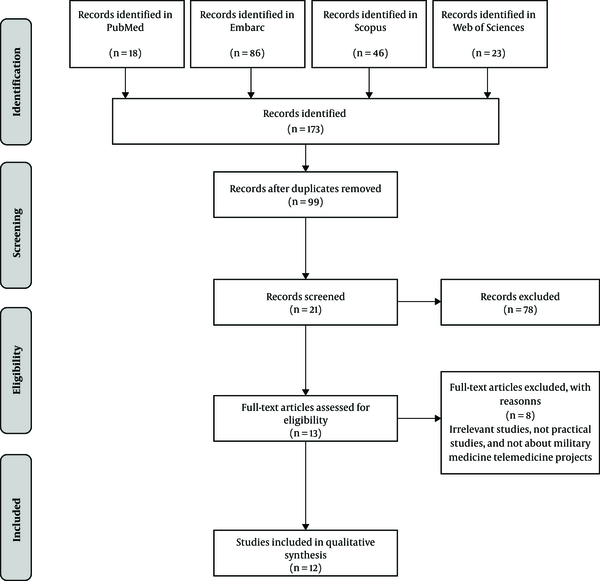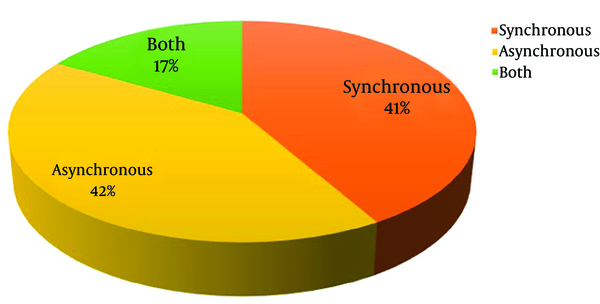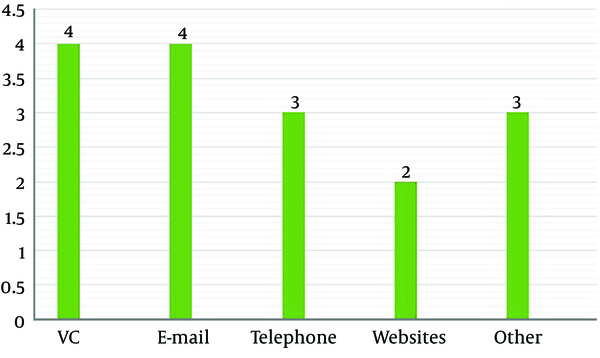1. Context
Military medicine is an academic discipline with extensive applications and fields. Military physicians generally practice a body of knowledge specific to the medical problems and needs of army forces, which is typically different from that of general medicine (1).
Physicians encounter serious challenges to provide comprehensive healthcare services for armed forces, and telemedicine is employed to resolve some of them. Health information technology, especially telemedicine, is an equipped supportive tool to provide health care for military medicine (2). In a military medical center, telemedicine is extensively used to identify injuries and diseases, support the treatment, rehabilitation, and aid the improvement of injured forces (3). According to the World Health Organization, telemedicine includes providing healthcare services by all specialists through exchanging accurate diagnostic information, preventing and treating diseases and injuries, and continuously evaluating and educating healthcare providers by the employment of information and communication technology (ICT) to enhance the health of the population (4, 5). Telemedicine is defined as the use of health information exchanged through telecommunications to improve clinical care (6). Telemedicine has many types, including real-time communication (synchronous) and store and forward communication (asynchronous) (7-9). Another feature relies on the physician’s specialty; e.g., Tele-Consultation, Tele-Orthopedics, Tele-Surgery, and Tele-Intensive Care Unit (ICU) (5). Telemedicine has specialized and general applications for military medicine. First, it enables physicians in military centers to treat a wide range of patients, especially when a high number of military forces are diffused in a wide area. The second application provides the condition for more physicians and specialists to be available for soldiers, staff, and other forces in remote areas (10).
Telemedicine improves health care quality, provides convenient access to health care services for deprived areas, and increases professional interactions between specialists. It also has other advantages such as reducing the costs and time spent on unnecessary health travels, enabling the physicians to provide professional healthcare services, facilitating the condition to exchange the health information between the specialists, and decreasing the mortality and morbidity rate through increasing the justice in health (4, 11-14). Considering these factors and the pivotal role of telemedicine in providing healthcare services in military medicine, many countries use the developed tools and applications.
The United States (US) Army used for the first time tele-radiology without picturing in the 1980s (15), which is the starting point of telemedicine use in military medicine in the world.
In 2000, a specialized telemedicine council was established in the North Atlantic Treaty Organization, while few countries used telemedicine at that time (16). Gradually, by the growth of telemedicine in the military medicine, different military forces including navy (17), air force (16), and army (18) started using its applications and tools overseas (16, 18) and in the mainlands (19) in case of possessing the technology, knowledge, and infrastructures. In recent years, telemedicine is used extensively.
2. Objectives
The development of supportive tools such as hardware, bandwidth increase (20, 21), limited number of physicians and other health care providing resources, and difficulty to access remote areas for many of the military forces made the developed countries employ telemedicine tools and programs (22). From 2014 to 2018, several studies were conducted on telemedicine in military medicine, and different countries used their experiences. The telemedicine projects conducted during these five years include useful experiences with specific features that can be used by different countries. The current study aimed at identifying the features of telemedicine programs implemented in military medicine worldwide.
3. Data Sources
The current systematic review was performed in 2018. PubMed, Web of Science, Embase, and Scopus scientific databases were searched by the combination of keywords shown in Table 1. All steps of the study were in accordance with the PRISMA statement (23). The searches were independently performed by two researchers; contradictions were resolved by consulting with a third party. The percentage of agreement among researchers was 83.33%. All articles retrieved from the first search were transferred to EndNote version 7 reference manager software. Table 1 shows the search strategy and keywords combination formula based on scientific databases.
| Item | Scientific Databases | Search Strategy | Timespan | Retrieved Articles |
|---|---|---|---|---|
| 1 | PubMed | (Tele medicine OR telemedicine OR tele-medicine OR telecare OR Telehealth) AND (Military Medicine OR Army Medicine) | 2104 - 2018 | 18 |
| 2 | Scopus | TITLE-ABS-KEY (Telemedicine OR telemedicine OR tele-medicine OR telecare OR telepath) AND (Military Medicine OR police medicine OR Army Medicine) AND ar) AND PUBYEAR > 2014 | 2014 - 2018 | 46 |
| 3 | Embase | (Tele medicine OR telemedicine OR tele-medicine OR telecare OR Telehealth) AND (Military Medicine OR police medicine OR Army Medicine) | 2014 - 2018 | 86 |
| 4 | Web of Science | (Tele medicine OR telemedicine OR tele-medicine OR telecare OR Telehealth) AND (Military Medicine OR police medicine OR Army Medicine) | 2014 - 2018 | 23 |
| Total | 173 |
The Search Strategy
The search strategy in scientific databases was limited to the articles, and to make the searches comprehensive, Yahoo and Google search engines and some other related websites were also searched as gray literature. A manual search was performed in the references of the selected articles.
4. Data Selection
All original articles published in the English language from 2014 to 2018 were involved. The inclusion criteria were the availability and relevancy of the articles and the absence of political subjects. The main inclusion criterion was the implementation of telemedicine programs in a military medicine field. The articles on fields except military medicine, such as natural disasters, were excluded. All other types of articles, including reviews, case reports, letters to/from editors, short communication, conferential articles, etc., published out of the mentioned timespan were excluded from the study.
To identify the possible risk of bias, the quality of the selected studies was investigated using the Newcastle-Ottawa scale (NOS) (24). Based on the quality assessment results, out of the 13 selected studies, 12 had a satisfactory quality, and one was excluded.
5. Data Extraction
After the selection of the articles, data extraction was performed using a researcher-made data extraction form designed based on the study objectives, including the telemedicine features. The form had four main parts: Study information (i.e., author’s name, the title of the article, year of publication, study design), objectives and methods (i.e., objectives, study type, data analysis), main findings including the features of telemedicine programs (i.e., types, infrastructures, instruments, country of origin, countries used the technology, specialists), and the applications and effectiveness of telemedicine in military medicine.
Content analysis was performed to extract data from the selected articles. Data were summarized by descriptive analysis and reported based on the study objectives in figures and tables.
6. Results
Out of the 173 articles found in the first round of the search, based on the inclusion and exclusion criteria, 12 articles were finally selected (Figure 1). No new or relevant study was found in the manual search and gray literature.
The study results showed that the majority of the studies were conducted in 2014 (n = 4). Table 2 indicates the main information of selected articles.
| Item | First Author’s Name | Study Objectives | Population and Sample Size | Requirements and Tools | Main Results |
|---|---|---|---|---|---|
| 1 | Waibel et al. (25) | To identify the role of the involved specialty, the specialty-trained presenter, and patient adoption to increase the success of telehealth deployment. | 2354 visits through telehealth methods | Not declared. | Most of the patients were satisfied with saving their time and money. |
| 2 | Frank and McCarthy (26) | To determine the role of dietary aide and physical activity coach on bone health during military deployment | 234 soldiers | A website, an email address, and internet communication for soldiers; baseline anthropometric measurements, uniformity of shorts, t-shirt, socks, and running shoes | The study results showed that dieting and exercise coaching were possible for deployed soldiers through telehealth practices, but had limited effects in short-term overseas deployment. |
| 3 | Choi et al.(27) | To determine the telemedicine application by the US military forces with type 1 diabetes. | 51 soldiers | Verification of pump settings, wireless downloads of data from a website, direct paging, and telephone access. | Telemedicine was effective in decreasing the A1C levels in the US military forces with type 1 diabetes. |
| 4 | Pelton et al. (28) | To help the treatment of acute stress disorder in a theater of war. | 1000 soldiers in the Afghanistan war | A room at the onset of the encounter, secured network, communication through telephone | Clinical videoconferencing had many advantages, especially for health caregivers pending future operational deployments. |
| 5 | Waterman et al. (29) | To determine the effectiveness of a military orthopedic tele-consultation program in casualty care. | 597 tele-consultation for army personnel | The e-mail system to consult | The used tele-consultation system was effective in orthopedic care under limited facilities; it was cost-effective, time-saving, and timely in military centers. |
| 6 | Ghbeis et al. (30) | To use tele-PICU in natural disasters. | 19 consults | Laptop computer, webcam, satellite internet, Facebook Messenger, and Skype were used to facilitate communication. | Civilians can benefit from tele-PICU to receive pediatric care; it can be utilized for educational purposes. |
| 7 | Bell et al. (31) | To explain a new protocol developed from a telephone program for short messages (SMs. | 400 military forces | Telephone, mail, and email | The study provided details of a new protocol on military telemedicine for the treatment of trauma. |
| 8 | Shin et al. (32) | To assess the accuracy of diagnostic tele-consultations in dermatology among military forces by a smartphone multimedia messaging service. | 100 army patients | Using digital cameras built into smartphones | The accuracy of diagnosis was close to the face-to-face visit. |
| 9 | Van Gent et al. (33) | To determine the first effect of telemedicine on patients admitted to ICU following a surgery. | 174 patients in ICU following a surgery | A joint website | It reduced the rate of patient transfer and ICU admission. |
| 10 | Davis et al. (34) | To describe the initial experiences in implementing this technology. | 171 patients | Hub site VTC, whereas NHCP utilized a Cisco Telepresence mobile VTC cart | Enhanced critical care quality and reduced costs associated with network disconnection |
| 11 | Faulkner et al. (35) | the aim of the study was development of a Tele ENT Program to Support Distant Military Treatment Facilities for the European Regional Medical Command | 92 patients | Polycom class HD video software onto the Computer work station, Karl Storz Hub, otoscope and nasopharyngoscope for linkage images for visualization for screen or transmission via the internet Medical devices: otoscope and nasopharyngoscope | Reduced the costs and was useful for training. A supportive instrument in some specific surgeries |
| 12 | Dave et al. (36) | To describe a case of tele-stroke outcomes in military medicine. | 3623 patients | Not declared. | The implementation of tele-stroke was an appropriate potential solution to provide primary healthcare for ischemic stroke. |
Articles Selected for Review
From the 12 selected studies, nine were performed by US Military Medicine. Other studies were conducted in South Korea, Germany, and one was a joint research project among Germany, Belgium, and Italy.
In terms of study type, eight studies were observational, and others were interventional.
The US, in addition to the internal garrisons, utilized telemedicine tools for its forces deploying overseas.
The current review showed that six of the studies were conducted in military garrisons or zones, three in the navy, and the other three in the war zones.
Figure 2 shows the synchronous and asynchronous telemedicine used in military medicine.
Results of the study showed that orthopedics (n = 4), intensive care (n = 3), and psychology and psychiatry (n = 3) were the dominant specialties that used telemedicine.
The most frequent types of telemedicine used in the selected studies included tele-consultation (n = 7), tele-orthopedics (n = 3), tele-ICU (n = 3), and tele-health (n = 3), followed by tele-stroke, tele-ENT, and tele-critical care.
Figure 3 shows the communication routes used by telemedicine in military medicine. Based on Figure 3, video conferencing (VC) and email were the most common communication routes.
Figure 3 shows other types of communication routes including virtual communication, multimedia messaging service, and health information systems; most of the telemedicine services in military medicine were delivered through the Internet.
7. Discussion
The study results showed that the US was the most advanced country using telemedicine in military medicine. Due to the implementation of various projects, US Military Medicine gained valuable experiences in telemedicine.
The results of the current study showed the application of different types of telemedicine in remote locations by military forces. Considering the result of the study, most destinations to implement telemedicine were overseas, where access to the physician was difficult. Gomez et al. (37), checked out the tertiary care telemedicine support by Walter Reed Army Medical Center for philanthropy missions in different countries.
Girard (3), introduced a telemedicine program to treat traumatic brain injury in American soldiers worldwide. In other countries with an extensive geographic extent, studies suggested the employment of telemedicine programs and described their potentials in a remote area.
The current study results showed that countries with telemedicine technology in military medicine used advanced infrastructures such as profitable portable platforms-i.e., tablets, personal digital assistants, and mobile phones to provide healthcare services. Regarding the pivotal role of infrastructures in the successful implementation of telemedicine in military medicine, it is suggested that policymakers and officials should utilize appropriate tools of telemedicine in military medicine.
Based on the obtained results, various medical specialties are used according to the case. Choi et al. (27) reported that the asynchronous telemedicine was used for patients with diabetes.
In another study, Ghbeis et al. (30), used synchronous telemedicine due to the nature of health services provided in ICU. Since timely care is essential in ICU, synchronous telemedicine should be employed in such critical care settings.
More attention should be paid to equipment and infrastructures to provide timely healthcare services by telemedicine, which is an important factor in its successful implementation.
To employ synchronous telemedicine, in addition to the basic equipment, the speed of the internet, advanced communication networks, bandwidth, and traffic volume should also be considered.
The teleconsultation was used more than other types such as tele-orthopedics and tele-ICU. Some studies emphasized the effectiveness of tele-consultation in both civilian and military environments (38-40). Asynchronous telemedicine is the most suitable type for tele-consultation (39). Therefore, it is suggested to utilize asynchronous tele-consultation in military medicine. In tele-ICU, tele-critical care, and sometimes tele-orthopedics, it is necessary to utilize synchronous telemedicine (41-43). Therefore, it is important to choose the most appropriate type of telemedicine.
The results of the current study showed that VC and email were the major telemedicine communication routes. VC technology needs more advanced equipment since it is used under real-time conditions. Military medicine, concerning the limited number of specialists and human resources, needs this technology and the VC equipment should be provided to improve the quality of healthcare services. In some cases, especially asynchronous telemedicine, the healthcare providers in military medicine use email as a more possible and convenient route of communication. The lack of related studies on telemedicine in military medicine was one of the main limitations of the current study, which can be attributed to military secrets.
8. Conclusions
The telemedicine tools and potentials have many advantages such as saving time for both patients and health care providers, reducing costs, providing support in natural disasters, enhancing healthcare services, and providing patients’ satisfaction with military medicine. Today, telemedicine applications are widely used by military medicine in developed countries. Based on the current study results, advanced information technology is needed to successfully use telemedicine. Due to the emergency needs and the importance of time for providing some healthcare services, the utilization of synchronous (real-time) plus asynchronous (store and forward) telemedicine methods (hybrid method) is suggested; such technologies require specific infrastructures such as high-speed domestic and worldwide web networks, increased bandwidth, and advanced medical equipment. Further studies by policymakers and decision-makers are recommended.


